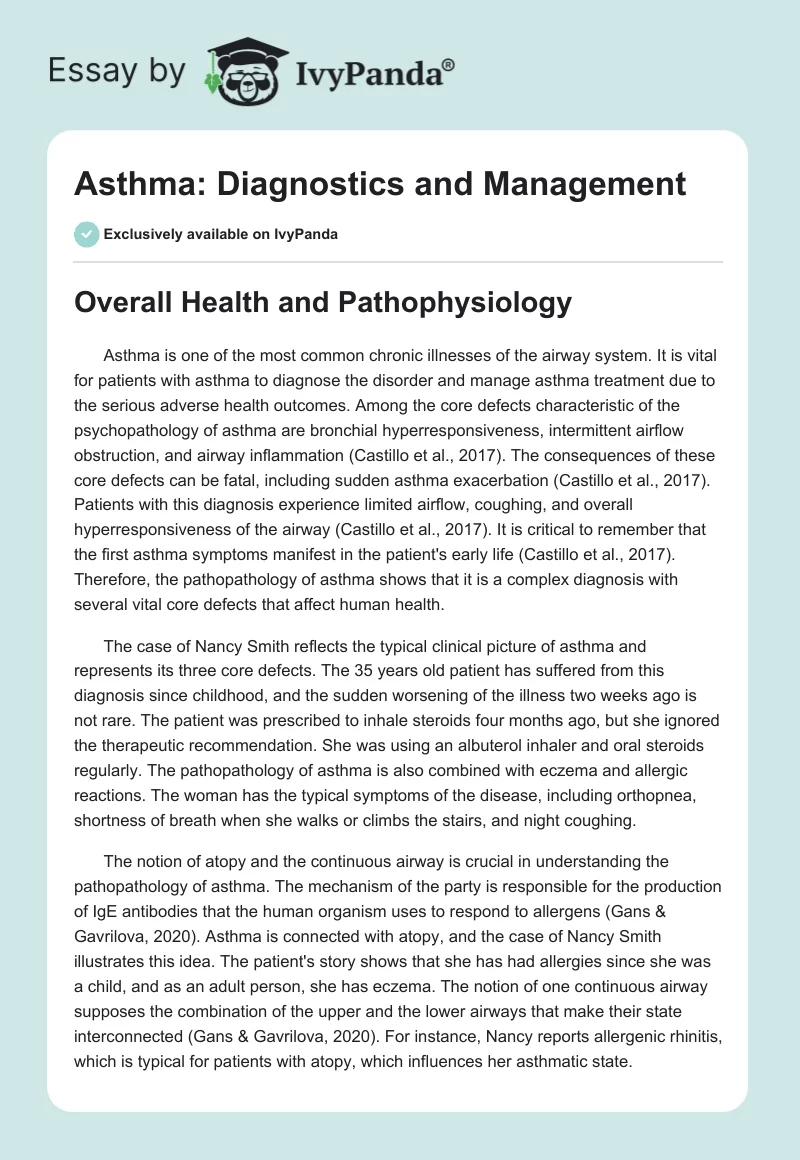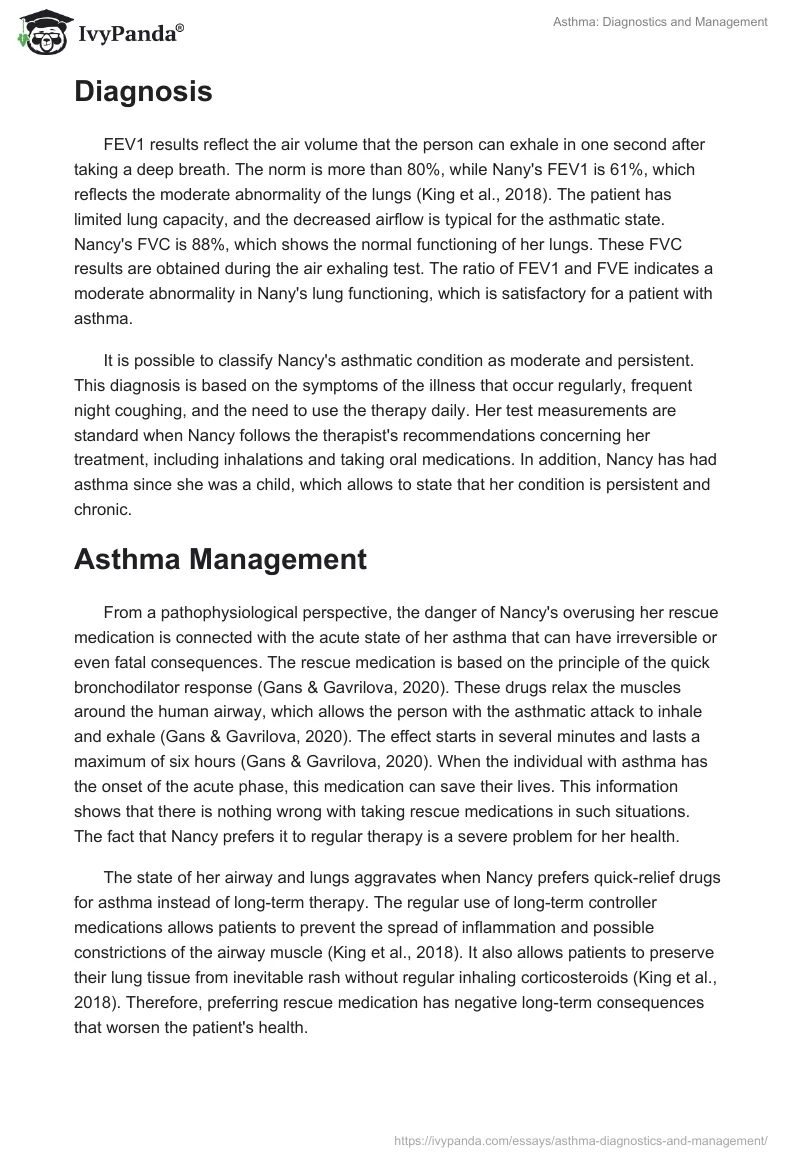Overall Health and Pathophysiology
Asthma is one of the most common chronic illnesses of the airway system. It is vital for patients with asthma to diagnose the disorder and manage asthma treatment due to the serious adverse health outcomes. Among the core defects characteristic of the psychopathology of asthma are bronchial hyperresponsiveness, intermittent airflow obstruction, and airway inflammation (Castillo et al., 2017). The consequences of these core defects can be fatal, including sudden asthma exacerbation (Castillo et al., 2017). Patients with this diagnosis experience limited airflow, coughing, and overall hyperresponsiveness of the airway (Castillo et al., 2017). It is critical to remember that the first asthma symptoms manifest in the patient’s early life (Castillo et al., 2017). Therefore, the pathopathology of asthma shows that it is a complex diagnosis with several vital core defects that affect human health.
The case of Nancy Smith reflects the typical clinical picture of asthma and represents its three core defects. The 35 years old patient has suffered from this diagnosis since childhood, and the sudden worsening of the illness two weeks ago is not rare. The patient was prescribed to inhale steroids four months ago, but she ignored the therapeutic recommendation. She was using an albuterol inhaler and oral steroids regularly. The pathopathology of asthma is also combined with eczema and allergic reactions. The woman has the typical symptoms of the disease, including orthopnea, shortness of breath when she walks or climbs the stairs, and night coughing.
The notion of atopy and the continuous airway is crucial in understanding the pathopathology of asthma. The mechanism of the party is responsible for the production of IgE antibodies that the human organism uses to respond to allergens (Gans & Gavrilova, 2020). Asthma is connected with atopy, and the case of Nancy Smith illustrates this idea. The patient’s story shows that she has had allergies since she was a child, and as an adult person, she has eczema. The notion of one continuous airway supposes the combination of the upper and the lower airways that make their state interconnected (Gans & Gavrilova, 2020). For instance, Nancy reports allergenic rhinitis, which is typical for patients with atopy, which influences her asthmatic state.
Diagnosis
FEV1 results reflect the air volume that the person can exhale in one second after taking a deep breath. The norm is more than 80%, while Nany’s FEV1 is 61%, which reflects the moderate abnormality of the lungs (King et al., 2018). The patient has limited lung capacity, and the decreased airflow is typical for the asthmatic state. Nancy’s FVC is 88%, which shows the normal functioning of her lungs. These FVC results are obtained during the air exhaling test. The ratio of FEV1 and FVE indicates a moderate abnormality in Nany’s lung functioning, which is satisfactory for a patient with asthma.
It is possible to classify Nancy’s asthmatic condition as moderate and persistent. This diagnosis is based on the symptoms of the illness that occur regularly, frequent night coughing, and the need to use the therapy daily. Her test measurements are standard when Nancy follows the therapist’s recommendations concerning her treatment, including inhalations and taking oral medications. In addition, Nancy has had asthma since she was a child, which allows to state that her condition is persistent and chronic.
Asthma Management
From a pathophysiological perspective, the danger of Nancy’s overusing her rescue medication is connected with the acute state of her asthma that can have irreversible or even fatal consequences. The rescue medication is based on the principle of the quick bronchodilator response (Gans & Gavrilova, 2020). These drugs relax the muscles around the human airway, which allows the person with the asthmatic attack to inhale and exhale (Gans & Gavrilova, 2020). The effect starts in several minutes and lasts a maximum of six hours (Gans & Gavrilova, 2020). When the individual with asthma has the onset of the acute phase, this medication can save their lives. This information shows that there is nothing wrong with taking rescue medications in such situations. The fact that Nancy prefers it to regular therapy is a severe problem for her health.
The state of her airway and lungs aggravates when Nancy prefers quick-relief drugs for asthma instead of long-term therapy. The regular use of long-term controller medications allows patients to prevent the spread of inflammation and possible constrictions of the airway muscle (King et al., 2018). It also allows patients to preserve their lung tissue from inevitable rash without regular inhaling corticosteroids (King et al., 2018). Therefore, preferring rescue medication has negative long-term consequences that worsen the patient’s health.
It allows stating that Nancy does not manage her asthma correctly, which is connected with a lack of patient understanding about the adverse consequence of her actions on her health. The critical thing for Nancy is to use long-term therapy, to use the inhaler, and to learn the methods of monitoring her health state to avoid the crisis. This information shows a critical need for improved therapeutic intervention in Nancy’s case because the woman has significant problems managing her health.
References
Castillo, J. R., Peters, S. P., & Busse, W. W. (2017). Asthma exacerbations: Pathogenesis, prevention, and treatment. The Journal of Allergy and Clinical Immunology In Practice, 5(4), 918–927. Web.
Gans, M. D., & Gavrilova, T. (2020). Understanding the immunology of asthma: Pathophysiology, biomarkers, and treatments for asthma endotypes. Paediatric Respiratory Reviews, 36, 118–127. Web.
King, G. G., James, A., Harkness, L., & Wark, P. (2018). Pathophysiology of severe asthma: We’ve only just started. Respirology, 23(3), 262–271. Web.


